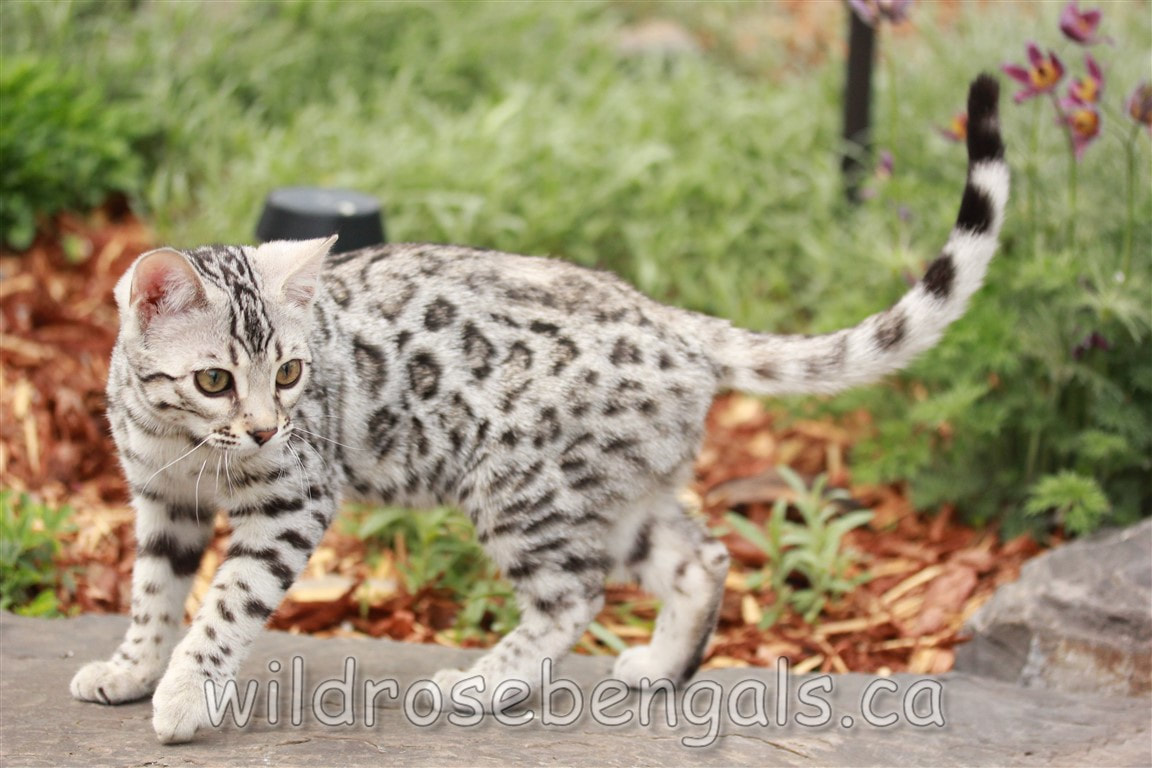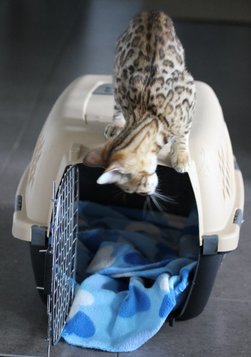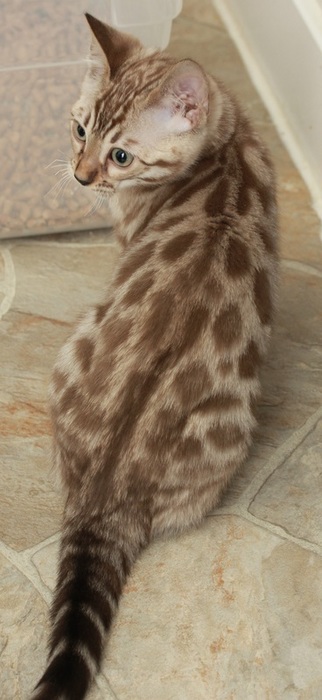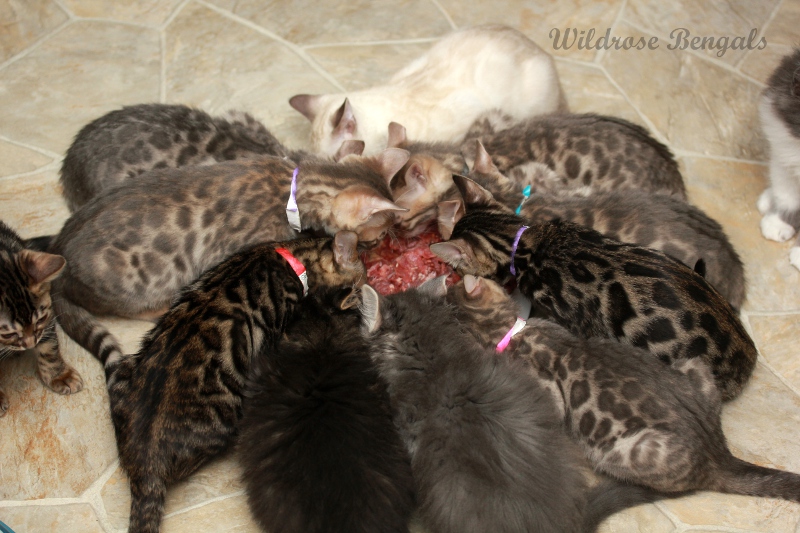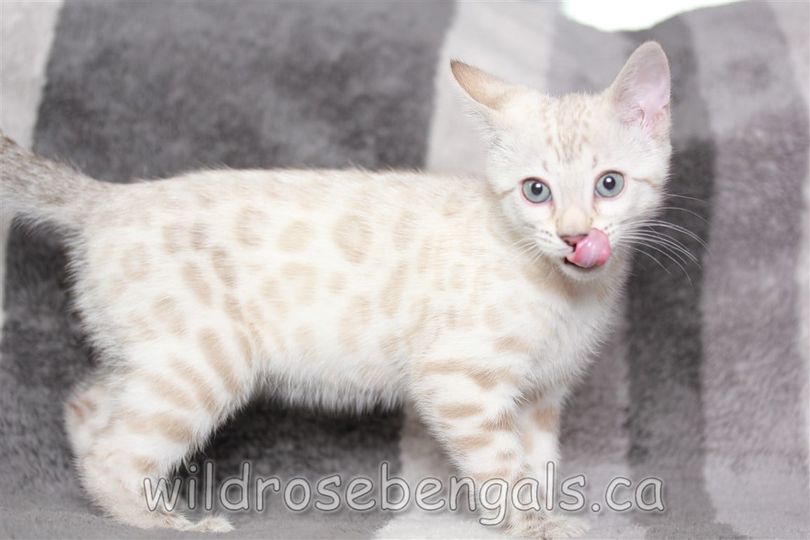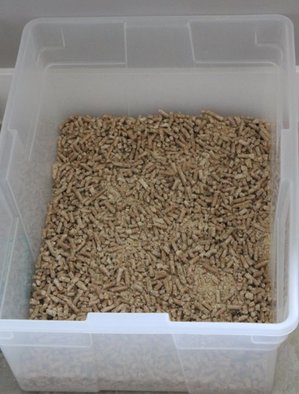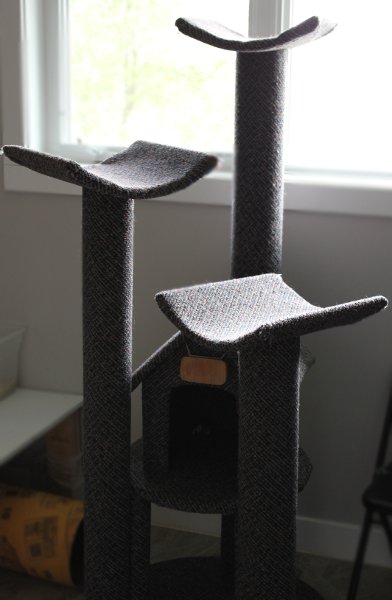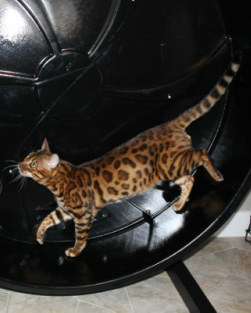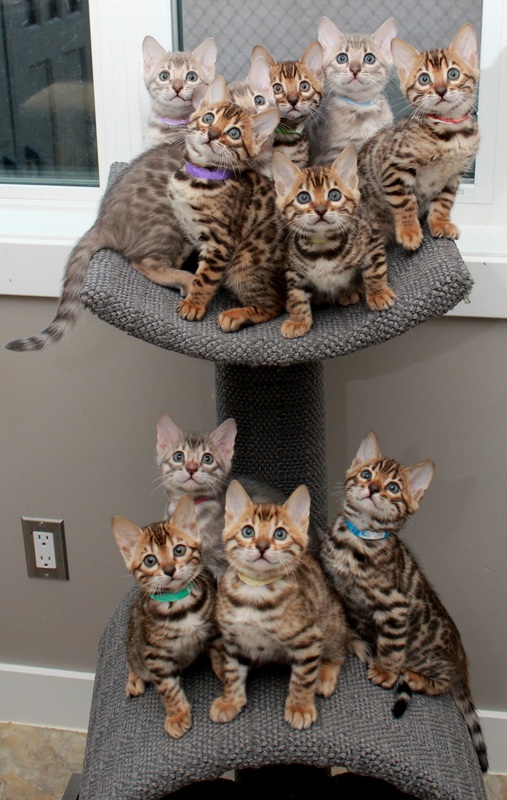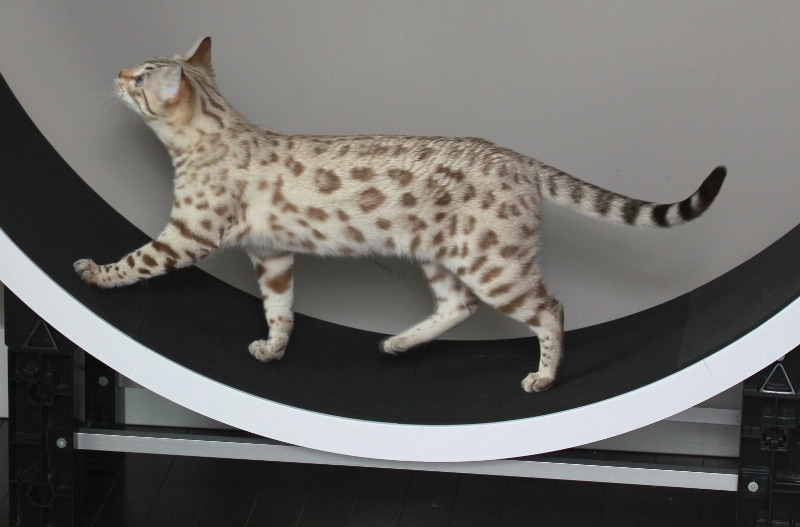Everything you'll need to know about...
Bringing your kitten home!
|
What to Bring when you pick up your kitten
~ Cat Carrier with small blanket or towel
~ Final Payment Balance - cash (unless previously paid by email money transfer) |
What we Send Home
~ TICA registration paper - Blue Slip
~ Health records (vaccinations & spay/neuter papers, free pet insurance-30 days) ~ Microchip Form (don't worry, this is fully paid for) ~ Contract ~ Food Sample (raw food) ~ Toys! ~ 30 days free Pet insurance with Trupanion ~ Your kitten !! |
Bringing your new kitten home!
|
As part of our contract if you have other pets you are required to separate your new kitten until it has been health checked by your veterinarian. We highly encourage that regardless if you have other pets, that you start your new kitten in one room. This room should be complete with food, water, litter, bed, toys and cat-tree (if possible). A room that does not have a bed for the kitten to hide under works best. This allows your kitten a chance to easily find its amenities (avoid accidents!) and feel comfortable faster. It means you can go to bed, to work, or other outings without worrying that your kitten will become lost in its new home and not know where their bathroom is!
It is best that your kitten stays in this room for about 1-2 weeks. During this time you will take your kitten for their vet check to ensure (s)he is healthy. This time with limited access allows your kitten to adjust to being in a new home, with new smells, and new people. Some kittens adjust rather quickly, while others take more time. Encourage and gain trust with your new kitten with food, toys and lots of pets and kind words. If your kitten is hiding or shy don't be discouraged. It can take 2-4 weeks before a kitten is completely comfortable with its new home and its new family. Don't leave your kitten to hide the entire time, a mistake would be to let the kitten 'come out on it's own'. Take time several times a day to find the hiding kitten and scoop them up and pet them, talk to, feed and play with them. They will quickly learn that you are fun to play with and will forget to be shy! With that being said, kittens are still babies so they do need some alone time to sleep and recharge their batteries just like us. It is very common for the kitten to have accidents when you first allow them out of their room. Keep in mind, at this age they are still babies. They get distracted easily, and can forget where the litter box is. To help with good litter box habits, you can periodically take them to the litter box. And have litter boxes in all areas of the house the use, especially ones they spend a lot of time in. It is best to start off allowing them to explore for short periods of time and increase over time until they are out all day. This allows them to get used to where things are, and still know where to find their litter box. New kittens will often cry for the ride home and during the first week. They are calling to see if anyone they know is around for company. They will settle in and the crying will turn to conversation to their new family :) |
Introduction to the home with other Pets
Step 1 - If you have other pets in the home, introduction will be a bit slower. Going slow is the key to success! Once your kitten has adjusted to their room in your home, you can start swapping blankets that smell like the other animals in your home, and do the same with one that smells like your kitten to help your other pets adjust. Watch the reaction of all animals involved, and once they seem to be fine with the scents, you can move on to the next step.
Step 2 - Now you can start letting your kitten explore your home a bit, but all other animals must be outside, or locked in another room while the kitten is out exploring. Start with short sessions, and lengthen over time. Allow your kitten to go at their own pace, although you can encourage exploration with a toy. This step allows the kitten to become familiar with your home without the stress of dealing with other pets. The kitten will be able to smell your other pets on furniture and cat trees, and later, your pets will smell the kittens scent on things as well. During this step you will need to watch your kitten for signs that he may need to go to the bathroom. Watch for scratching, especially in corners, and squatting. If you see these signs, put your kitten in the litter box. If he jumps out immediately but you think he needs to go, put him back in his room for a bit. Sometimes they are just so excited about exploring that they wait until the last second to go potty, and then can't find a litter box. Step 2 & 3 can be done at the same time.
Step 3 - If you previously had more than one animal in the home, you will want to do this step for each one individually so as not to overwhelm the kitten. Place the kitten in a crate and allow one pet access to sniff the kitten in the crate. Just do a few minutes at a time so you don't stress out either animal. You can swap out who is in the crate. Continue with this step until there is no negative behavior (hissing, growling). If there is just some very minor hissing after a few attempts, you can try moving on to step 4.
Step 4 - It's time to let them go face to face! Always watch their interactions closely for this step, as it can go bad quickly. A bit of swatting is normal, and hissing is okay too. If there is a lot of growling though, you may want to go back to Step 3. And if there is any major aggression, definitely go back to Step 3. It can take several weeks before your pets will tolerate each other, and even longer to become friends. Redirection with toys can also help make it a more pleasant experience for them, and helps them forget they are unhappy about their new "friend".
Please Note: If your other pets include a dog, ensure the kitten has a way to explore where the dog does not have access. The kitten will need to easily be able to get to their litter box without worry that the dog could get them. Using baby gates to keep your dog in certain areas works very well. Our kittens are all socialized with our dog, so they are familiar with them. However, it may still take time to adjust to your dog. And if your dog has never been around a cat, you will need to be extra watchful, and never leave them alone together until you are 100% certain there is no threat to the kitten.
Step 1 - If you have other pets in the home, introduction will be a bit slower. Going slow is the key to success! Once your kitten has adjusted to their room in your home, you can start swapping blankets that smell like the other animals in your home, and do the same with one that smells like your kitten to help your other pets adjust. Watch the reaction of all animals involved, and once they seem to be fine with the scents, you can move on to the next step.
Step 2 - Now you can start letting your kitten explore your home a bit, but all other animals must be outside, or locked in another room while the kitten is out exploring. Start with short sessions, and lengthen over time. Allow your kitten to go at their own pace, although you can encourage exploration with a toy. This step allows the kitten to become familiar with your home without the stress of dealing with other pets. The kitten will be able to smell your other pets on furniture and cat trees, and later, your pets will smell the kittens scent on things as well. During this step you will need to watch your kitten for signs that he may need to go to the bathroom. Watch for scratching, especially in corners, and squatting. If you see these signs, put your kitten in the litter box. If he jumps out immediately but you think he needs to go, put him back in his room for a bit. Sometimes they are just so excited about exploring that they wait until the last second to go potty, and then can't find a litter box. Step 2 & 3 can be done at the same time.
Step 3 - If you previously had more than one animal in the home, you will want to do this step for each one individually so as not to overwhelm the kitten. Place the kitten in a crate and allow one pet access to sniff the kitten in the crate. Just do a few minutes at a time so you don't stress out either animal. You can swap out who is in the crate. Continue with this step until there is no negative behavior (hissing, growling). If there is just some very minor hissing after a few attempts, you can try moving on to step 4.
Step 4 - It's time to let them go face to face! Always watch their interactions closely for this step, as it can go bad quickly. A bit of swatting is normal, and hissing is okay too. If there is a lot of growling though, you may want to go back to Step 3. And if there is any major aggression, definitely go back to Step 3. It can take several weeks before your pets will tolerate each other, and even longer to become friends. Redirection with toys can also help make it a more pleasant experience for them, and helps them forget they are unhappy about their new "friend".
Please Note: If your other pets include a dog, ensure the kitten has a way to explore where the dog does not have access. The kitten will need to easily be able to get to their litter box without worry that the dog could get them. Using baby gates to keep your dog in certain areas works very well. Our kittens are all socialized with our dog, so they are familiar with them. However, it may still take time to adjust to your dog. And if your dog has never been around a cat, you will need to be extra watchful, and never leave them alone together until you are 100% certain there is no threat to the kitten.
Feeding
|
Supplements
It is very important to ALWAYS add TAURINE to the raw food, 1/16th of a tsp daily. This is a water soluble vitamin so you don't need to worry if you give extra. We also highly suggest adding a good multivitamin to the food. We are using NuVet Plus Feline powder. It contains 33 different vitamins, minerals, antioxidants, essential amino acids, and many other micronutrients. It also contains Taurine, so you don't need to deal with multiple supplements. This supplement is a wonderful addition to any feline diet. Changing food
It is highly recommended that you do not switch the kittens food during their transition period (other than to another brand of balanced raw). Just the transition alone can cause them a lot of stress, adding a food change into the mix could cause things to go very poorly. I do not recommend feeding dry food (kibble) under any circumstance. Cats do not have a high thirst drive, so when eating a dry food diet they can be in a constant state of mild dehydration which will lead to health issues. If feeding a Raw diet just will not work for you, then I highly suggest feeding Dehydrated raw (with added water) or a high quality canned food that has minimal filler (grains, rice, wheat, vegetables, fruit) and lots of protein. If you would like to feed something other than what they are currently eating, we recommend slowly introducing the new food by giving them a bit more each day and reducing their previous food. Switching to a different brand of food WILL give the kitten soft stools unless you are switching to a different high quality balanced raw food. |
How much?
When you bring your kitten home they will likely be eating about a heaping teaspoon of raw food twice a day. If your kitten devours the food quickly, offer them more. You never want to limit your kittens food intake during their first year. They are growing and will typically only eat what they need. As your kitten grows, you will need to increase the amount of food you offer. It may get to a point where you think they are eating an insane amount of food, but we have seen young boys eat up to a pound of food in a day. Don't worry, they will slow down! Most of our adults eat about 1/3 - 1/2 lb per day ( in two feedings) What kind? We always recommend a good quality balanced raw diet, as that is the best thing for cats (more info below). Offering different proteins is always a good idea as well. They get different vitamins from each protein. By feeding a variety it also helps prevent them from becoming picky. Sometimes cats can develop allergies to certain proteins, and if they have only ever been fed one kind, it may be difficult to get them to eat something else. Obligate Carnivore Cats are considered obligate carnivores and therefore should be eating an exclusively meat/organ/bone diet with only a VERY small amount of added fiber. In the wild they would get this partially digested fiber from the stomachs of the mice they eat. Here is some great information on what it means to be an Obligate Carnivore. Here is another link to a great site with info on feeding raw. What I am feeding I am currently feeding a pre-made raw diet purchased at Real Deal Meats & Grand Dog Essentials (get 10% of at Grand Dog Essentials when you use this link!), however have made my own raw for the cats in the past. I don't always make the mix exactly the same, but typically feed raw chicken with bone, chicken hearts, beef liver, and beef kidney. For the kittens I grind everything on a course grind (3/4" plate). For our adults I feed the ground as well, but also feed the chicken hearts whole and give them whole chicken drumsticks or thighs a few times per week. By feeding larger pieces it allows them to work their jaw and clean their teeth. It also causes them to produce more saliva which helps digest their food better. We feed all of our cats twice per day (morning & evening), kittens are fed more frequently but by the time they are ready to leave they should be fine with two feedings per day. It is very important that cats have the proper amount of bone and organs in their meat. DO NOT buy raw that has fruit and/or vegetables in it, cats cannot digest this and don't typically like it very much. Click here to see the recipe I use
The ratio I suggest is as follows: 80% meat (20-30% of this is Heart), 10% bone (from chickens), 5% Liver, and 5% Kidney. You can also add in a bit of pumpkin (this is in place of the fiber they would get from a mouse's stomach). I typically mix up a huge batch and bag it in medium freezer bags.
|
|
Cat Trees
We highly recommend having a cat tree that's at least 3 feet tall with at least one level useable for a place for the cat to sleep. They will scratch and play and sleep on them. They recognize them as their own 'special place'. They should be located in a place that the family occupies frequently, in a lower traffic area (ie. a corner of a room vs right beside a busy hallway) and having it located near a window where they can bask in the sun is always a bonus! Cat Exercise Wheels Because of how much energy Bengals have, an exercise wheel is an excellent investment. It is a great way for them to stay in shape and provides entertainment for them throughout the day while you are away at work. Wheels have been shown to curb bad behaviours and give you a happier Bengal :) We are now able to offer Cat Wheels again! Please see the Cat Wheels page for information! Interactive toys are also great to keep them entertained. And you can try rotating the toys that they have access to so that they don't get bored of them as easily. |
